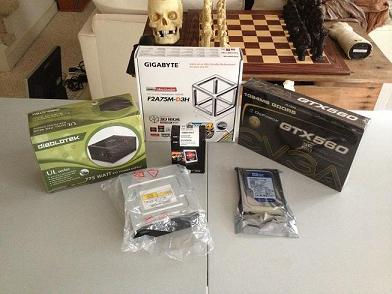
The Virtual Pinball Machine
The PC
Before this project, I had never built a PC--I'd always ordered one from Gateway or Dell, or I bought one off the shelf. The problem is that off-the-shelf and pre-built PCs as far as building a virtual pinball cabinet is concerned is that they either skimp on some vital component you need (like a good video card) or they have a ton of features you don't need. In many cases, both.
The pleasant surprise was that it is actually super-easy to build a PC. Just follow all of the instructions and diagrams and, a couple hours later, you'll have a functioning PC.
Then, you have to install Windows. And that's a whole other story.

Installing XP (A Floppy Drive? Really?)
Based on the posts on vpforums, Windows XP seemed like the best choice for an operating system (remember, this is based on 2012 information...your operating system may vary). That worked out well because I had access to a free copy. Unfortunately, XP is old, and it causes problems. Specifically, it cannot recognize a SATA hard drive without first loading SATA drivers...FROM A FLOPPY DISC.
So, you have to copy the drivers from the motherboard driver disc to a 3.5" floppy (which requires another computer with a CD-ROM drive and a floppy drive) and you need a USB floppy drive on the new system in order to load the drivers. What a pain. I never thought that, in the 21st century, I'd need to buy a floppy drive.
Eventually, I got XP installed. It's worth noting that several people have told me there's a way around the whole "you need a floppy drive" thing, but I don't know anything about it. I don't need to--I'm now the "proud" owner of a USB floppy drive.
Oh...one final tip: TURN OFF YOUR POWER-SAVE FEATURE IN WINDOWS! There is nothing scarier than having all of your monitors go blank on you in the middle of a game.
Setting Up Your Monitors
I've been using two-monitor setups at work for over a decade. At home I run a three-monitor setup. At home, I'm using an iMac. On a Mac, to get the second and third monitors working, you just plug them in. The computer asks you where the other monitors are in relationship to the main one and you simply drag the icons for the second and third screens into position and close the dialog. God, I love Macintoshes...
This was my first time trying a Windows multi-display setup on my own.
The first challenge was getting the machine to recognize that two of the motherboard's video outputs AND a separate video card were in use at the same time. I could get one or the other to work but not both. If you search the Internet for help on this problem, the general consensus is that it's impossible to enable both at the same time.
I'm here to tell you that this is patently FALSE.
The secret lies in getting the proper drivers installed. Just because you install the drivers from the CDs that come with the motherboard and the video card, don't assume that you've got the latest drivers. Quite the opposite, in fact. Assume that the drivers you get with your brand-spanking new devices are pure, unadulterated, useless crap and immediately surf to the manufacturer web sites and download the latest drivers. It's been so long since I set up a Windows machine that I had completely forgotten that very important rule.
(As an aside--this applies to the audio drivers as well. Yes, you just went to the motherboard manufacturer's web site and downloaded the 150 MB driver file for the motherboard and that made the video work. But, for some reason, the motherboard drivers don't include sound drivers--even thought he sound board is on the motherboard just like the video outputs are! Sigh.)
Anyway--after you download the drivers, you should have an image on all of your monitors. Here's what you want to do to get them set up:
-
Right click on the desktop on any monitor and select Properties.
-
Click the Settings tab.
-
Click Identify. A number appears on all of your monitors so that you can see which icon represents each monitor in the Settings dialog.
-
Right-click the icon for the playfield monitor and set it as your primary monitor (it doesn't matter what numeric designation it has).
-
Left-click on each of the other monitor icons and check the "Extend my Windows desktop onto this monitor" checkbox at the bottom of the Settings dialog.
-
Click and drag the monitor images in the Properties window so that the three monitors are lined up top edge to top edge (see the screen shot). If you don't do this, you'll have image size and alignment problems in the pinball software.
-
Click OK to exit.

Right-click on the desktop again. On the menu, there should be a selection for each of your video card utilities. In my case, there's an AMD utility for the motherboard video and a GeForce utility for the video card. You need to use these to set the resolution of the three monitors.
Set the resolutions as follows. (At least, this is what worked for me...):
-
Playfield monitor: 1680 x 1050
-
Backglass monitor: 1280 x 768
-
DMD monitor: 1024 x 768